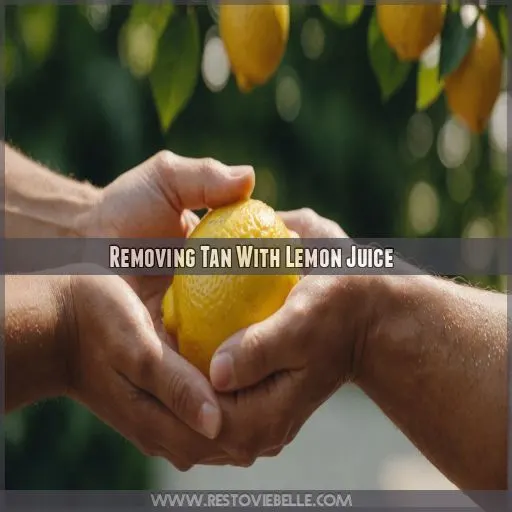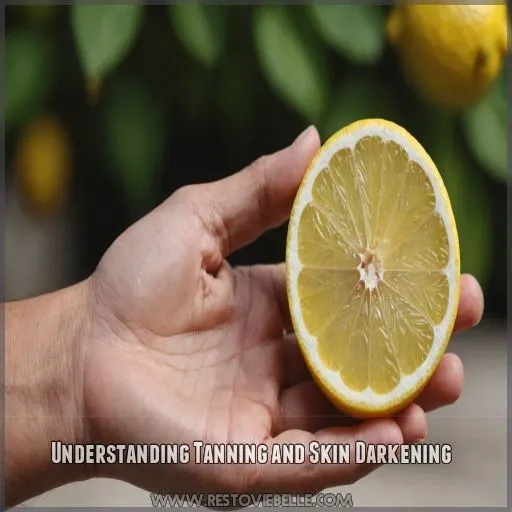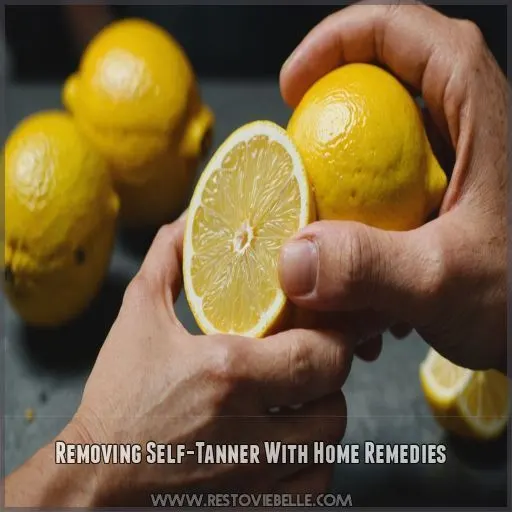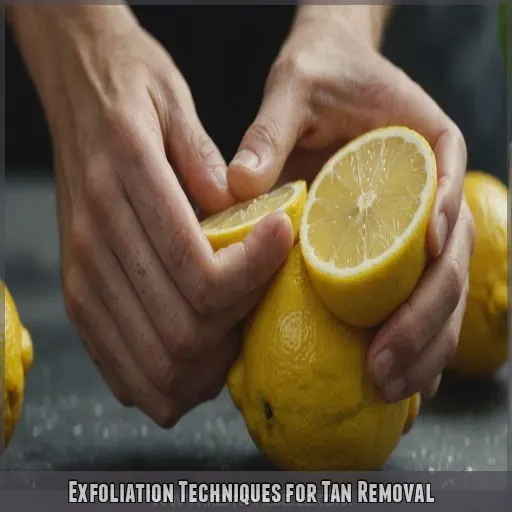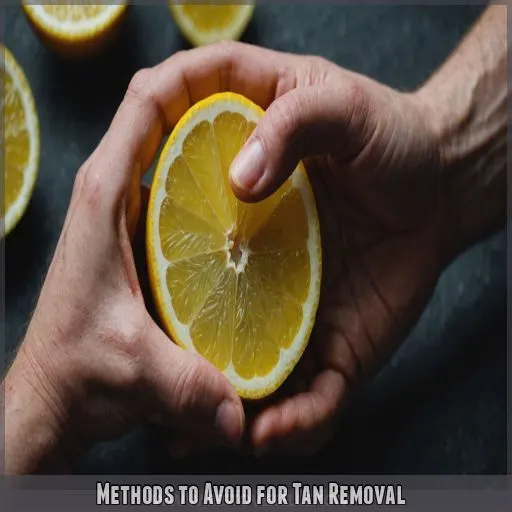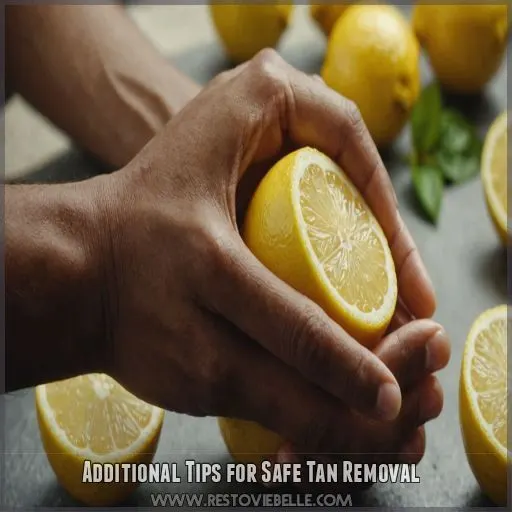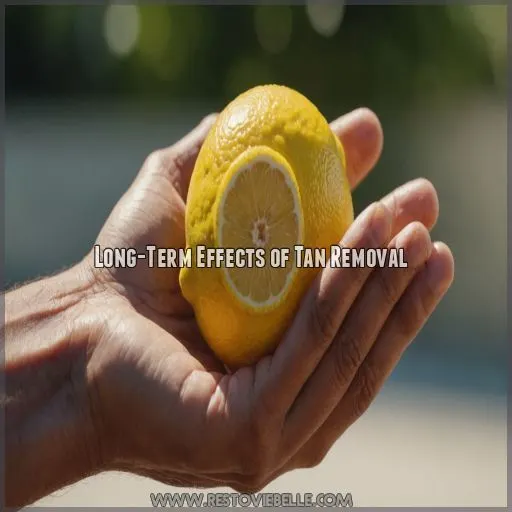This site is supported by our readers. We may earn a commission, at no cost to you, if you purchase through links.
 Want to know how to remove tan from skin using lemon juice? You’re in luck! This citrusy superhero can help you bid farewell to unwanted tans.
Want to know how to remove tan from skin using lemon juice? You’re in luck! This citrusy superhero can help you bid farewell to unwanted tans.
Here’s the scoop: lemon juice’s vitamin C and citric acid work together to exfoliate dead skin cells and lighten dark spots.
But hold your horses, don’t go slathering pure lemon juice on your skin! Mix it with water (1:1 ratio) to avoid irritation. For sensitive skin, go for a 1:3 lemon-to-water ratio.
Apply this concoction to tanned areas for 15-20 minutes, then rinse.
Remember to patch test first and use sunscreen to prevent future tanning.
Table Of Contents
- Key Takeaways
- Removing Tan With Lemon Juice
- Understanding Tanning and Skin Darkening
- Natural De-Tanning Methods With Lemon Juice
- Removing Self-Tanner With Home Remedies
- Exfoliation Techniques for Tan Removal
- Methods to Avoid for Tan Removal
- Additional Tips for Safe Tan Removal
- Other De-Tanning Methods Using Lemon Juice
- Long-Term Effects of Tan Removal
- Frequently Asked Questions (FAQs)
- Does lemon juice get rid of a tan?
- What is the fastest way to remove tan?
- How to remove self-tanner immediately with home remedies?
- How long does lemon and honey take to remove tan?
- How long does it take to see results?
- Can lemon juice be used on sensitive skin?
- Are there any side effects of using lemon juice?
- How often should lemon juice be applied for tanning?
- Can lemon juice remove deep, persistent tans effectively?
- Conclusion
Key Takeaways
- You’re not alone in your quest for a tan-free glow. Lemon juice can be your citrusy sidekick, thanks to its vitamin C and citric acid, which exfoliate and lighten dark spots. Just remember, it’s not a magic eraser – patience is key, and you’ll start seeing results in about 2-3 weeks with consistent use.
- Don’t go full lemon. Always dilute lemon juice with water (1:1 ratio, or 1:3 for sensitive skin) to avoid irritating your skin. Think of it as making lemonade for your skin – too sour, and it’ll pucker up in protest.
- Protect and pamper your skin throughout the de-tanning process. Slather on sunscreen regularly, moisturize thoroughly, and treat your face to a balanced diet of skin-loving foods. Your skin will thank you by glowing from the inside out.
- While lemon juice can be effective, it’s not for everyone. If your skin is extremely sensitive, consider gentler alternatives like diluted apple cider vinegar or aloe vera gel. And when in doubt, don’t hesitate to consult a dermatologist – they’re like skin experts who can guide you to your best complexion.
Removing Tan With Lemon Juice
You’ve probably heard that lemon juice can help remove a tan, but is it safe and effective? Let’s explore how to use lemon juice for tan removal, including its benefits, precautions, and proper dilution methods to keep your skin happy and healthy.
Benefits of Using Lemon Juice for Tan Removal
Lemon juice can work wonders for tan removal. It’s like a natural bleach for your skin, packed with vitamin C and citric acid. Here’s why it’s a game-changer:
- Exfoliates dead skin cells
- Lightens dark spots
- Bo
Precautions When Using Lemon Juice on Skin
While lemon juice can work wonders for your tan, it’s not without risks. You’ll want to tread carefully to avoid any unwanted side effects. Let’s look at some precautions to keep in mind:
| Precaution | Why It Matters |
|---|---|
How to Dilute Lemon Juice for Safe Use
Anyone can safely dilute lemon juice for tan removal.
Mix equal parts lemon juice and water to start.
If you have sensitive skin, try a 1:3 ratio instead.
For a gentler option, blend lemon juice with rosewater or aloe vera gel.
Always patch test first to avoid any unwanted surprises!
Understanding Tanning and Skin Darkening
You’ve probably noticed your skin getting darker after a day in the sun, but do you know why? Understanding the causes of tanning and its effects on your skin health can help you make informed decisions about sun protection and tan removal.
What Causes Skin Darkening and Tanning
Ever wondered why your skin darkens in the sun? It’s all about melanin, your body’s natural sunscreen. When UV rays hit your skin, melanin production kicks into overdrive. This process can be influenced by:
- Genetics (thanks, Mom and Dad!)
- Sun exposure intensity
- Time spent outdoors
- Your skin type
While a tan might look fab, it’s actually your skin’s SOS signal. Let’s look at safer alternatives for that sun-kissed glow!
Effects of Tanning on Skin Health
Tanning isn’t just a cosmetic issue – it’s a sign your skin’s taking a hit.
You’re at higher risk for skin cancer, and those UV rays can speed up aging.
Plus, your skin might become uneven or blotchy.
It’s like your skin’s crying out for help!
But don’t worry, we’ve got solutions.
Importance of Sunscreen in Preventing Tanning
Before you step out into the sun, remember that sunscreen is your skin’s best friend. It’s not just about avoiding a burn; it’s your secret weapon against unwanted tanning. Here’s why sunscreen is
Natural De-Tanning Methods With Lemon Juice
You’ve probably heard that lemon juice can help remove a tan, but did you know there are several ways to use it? Let’s explore three natural de-tanning methods using lemon juice that you can easily whip up at home.
Lemon Juice and Turmeric Mask
Now that you understand tanning, let’s explore a natural remedy. You’ve probably heard about turmeric’s benefits, but did you know it can help remove your tan? Mix 2 tablespoons of lemon juice with 1 teaspoon of turmeric powder. Apply this golden paste to your skin for 20 minutes, then rinse. It’s like giving your skin a mini-vacation from that unwanted tan!
Lemon Juice and Sugar Mask
Another sweet solution for your tan troubles? Mix
Lemon Juice and Honey Mask
Now, let’s mix up a sweet treat for your skin with a l
Removing Self-Tanner With Home Remedies
If you’ve gone a bit overboard with self-tanner, don’t worry – there are simple home remedies to help you out. Let’s explore some easy and effective methods to remove that streaky or too-dark self-tanner using items you probably already have in your kitchen. You can try removing hair toner to remove the tan.
.
Using Baking Soda to Remove Self-Tanner
Baking soda, the kitchen superhero, can rescue you from self-tanner mishaps. Mix it
Using Vinegar to Remove Self-Tanner
Now, let’s move on to another household staple: vinegar. It’s not just for salad dressing! For removing self-tanner, vinegar can be your secret weapon. Here’s how to use it:
- Dab vinegar on a cotton ball
- Gently rub it on tanned areas
- Rinse after 1-2 minutes
Using Gentle Nail Buffer for Calloused Areas
While vinegar can be effective, let’s explore another gentle option for those
Exfoliation Techniques for Tan Removal
You’ve got the tan, now
Chemical Exfoliation Methods
Now that you’ve tackled self-tanner removal, let’s explore chemical exfoliation. This method uses acids to gently dissolve dead skin cells, revealing fresher skin underneath. AHAs like glycolic acid and BHAs like salicylic acid are your go-to options. Start with a low concentration and use once a week. Remember, your skin might feel a bit tingly – that’s normal! But if
Mechanical Exfoliation Methods
You’re ready to say goodbye to that stubborn tan, and you’re armed with your trusty exfoliating tools.
From DIY scrubs to body brushes, mechanical exfoliation offers a hands-on approach to revealing fresher skin.
But be careful – your skin isn’t a scratching post!
Consider gentler options like microdermabrasion for sensitive areas.
Your skin will thank you for the TLC.
Importance of Moisturizing After Exfoliation
After exfoliating, your skin’s like a fresh canvas – ready for some TLC.
Don’t skimp on moisturizing! It’s really important for maintaining your skin barrier and preventing dryness.
Slather on a hydrating lotion to lock in moisture and keep your newly revealed skin looking healthy sensitive skin tips.
.
Your skin will thank you with a radiant, tan-free glow!
Methods to Avoid for Tan Removal
While you might be tempted to try quick fixes for tan removal, some methods can do more harm than good. Let’s explore a couple of popular but risky approaches you should steer clear of to keep your skin safe and healthy.
Risks of Using Undiluted Lemon Juice
While lemon juice can be a skin-brightening superhero, using it undiluted is like playing with fire. You might be tempted to go full-strength for faster results, but pump the brakes! Undiluted lemon juice can cause a world of trouble, including skin irritation that’ll have you feeling like a lobster in a boiling pot. Sun sensitivity? You bet – hello, unwanted tan! Acne breakouts might crash your clear skin party, and the bleaching effects could leave you with patchy skin that’s far from your #skingoals. Salicylic acid benefits can help clear blemishes and even out skin tone.
. In extreme cases, chemical burns are a real risk. Stick to diluted versions to keep your skin happy and healthy.
Why Windex is Not Suitable for Skin
Cleaning enthusiasts, beware! You might be tempted to grab that bottle of Windex to zap away your tan, but hold your horses.
Windex is a no-go zone for your skin. It’s packed with harsh chemicals that can wreak havoc on your delicate epidermis.
We’re talking potential chemical burns, severe irritation, and long-term skin damage.
Imagine your skin as a sensitive flower – you wouldn’t douse it with glass cleaner, would you?
Additional Tips for Safe Tan Removal
When it comes to removing a tan safely, there’s more to think about than just lemon juice. Let’s explore some additional tips that’ll keep your skin healthy and gl
Importance of Consulting a Dermatologist
While DIY tan removal methods can be tempting, it’s important to consult a dermatologist for professional advice. They can assess your skin’s health and recommend safe, effective solutions that are right for you. Here’s why you should seek expert guidance:
- Skin cancer prevention
- Personalized tan removal options
- Professional sun damage assessment
Don’t let your desire for a quick fix cloud your judgment. Your skin’s health is worth the extra step of consulting a pro.
Staying Hydrated and Protected From the Sun
While battling tan, don’t forget to hydrate and shield yourself from the sun’s rays. Drink plenty of water to keep your skin plump and ra
Maintaining a Balanced Diet for Skin Health
You’ve got your water and sunscreen game down, but don’t forget about your plate! A balanced diet can work wonders for your skin health. Try incorporating these skin-friendly foods:
- Omega-3-rich salmon for that dewy glow
- Vitamin C-packed citrus fruits to boost collagen
- Antioxidant-loaded berries to fight off free radicals
Other De-Tanning Methods Using Lemon Juice
You’ve probably heard about using lemon juice to remove your tan, but did you know there are other creative ways to incorporate it? Let’s explore some lesser-known methods that combine lemon juice with other household ingredients for effective tan removal. Lemon juice hair lightening is a popular DIY method, but it’s important to be aware of the potential risks and side effects.
.
Lemon Juice and Baking Soda Paste
Now, let’s explore another DIY de-tanner using lemon juice. You can create a powerful paste by mixing lemon juice and baking soda for lightening beard dye.
. Here’s
Baby Oil and Baking Soda Paste
A classic duo in your pantry might just be your ticket to tan-free skin.
Mix baby oil and baking soda in equal parts to create a gentle exfoliating paste.
Apply it generously, let it soak for 10-15 minutes, then rinse off in the shower.
Don’t have baby oil? No worries! Olive or coconut oil work just as well for this DIY tan removal technique.
Using Vinegar With Caution
With vinegar, you’re dancing on a tightrope of skincare. Dab
Long-Term Effects of Tan Removal
While removing a tan can give you a fresh look, it’s important to think about the long-term effects on your skin. Let’s explore how to prevent damage, keep your skin moisturized, and maintain healthy skin after tan removal.
How to Prevent Skin Damage From Tan Removal
While lemon juice can help remove your tan, it’s important to protect your skin from damage during the process. Here are some tips to keep your skin healthy:
- Use gentle, pH-balanced cleansers
- Apply sunscreen religiously
- Avoid harsh scrubs or chemicals
- Stay hydrated inside and out
- Give your skin regular breaks from treatments
Importance of Moisturizing After Tan Removal
After removing your tan, don’t forget to moisturize! Your skin’s been through the wringer, so it’s thirsty for some TLC. Think of moisturizing as giving your skin a big, comforting hug. It’ll help prevent dryness, maintain your skin barrier, and keep your complexion looking fresh. Choose a moisturizer that suits your skin type – it
How to Maintain Healthy Skin After Tan Removal
After removing your tan, maintaining healthy skin is important for long-term benefits. You’ll want to establish a consistent skincare routine that focuses on nourishment and protection. Here’s a quick list to keep your skin glowing:
- Slather on moisturizer like it’s going out of style
- Guzzle water like a camel in the desert
- Feast on a rainbow of fruits and veggies
- Shield your skin from the sun’s sneaky rays
Frequently Asked Questions (FAQs)
Does lemon juice get rid of a tan?
While lemon juice isn’t a magic eraser, it can help fade your tan. You’ll need patience, but its natural bleaching properties can lighten skin over time, just like natural hair lightening can gradually brighten hair.
. Just don’t overdo it—moderation is key to avoiding irritation.
What is the fastest way to remove tan?
While there’s no lightning-fast fix, exfoliating regularly and using skin-lightening products can speed up tan removal. Don’t forget to moisturize and protect your skin with sunscreen. Remember, slow and steady wins the race in skincare!
How to remove self-tanner immediately with home remedies?
You can quickly remove self-tanner at home with these remedies: Mix lemon juice and baking soda into a paste, apply for 5 minutes. Or, try baby oil and baking soda. For stubborn spots, gently exfoliate with a sugar scrub.
How long does lemon and honey take to remove tan?
Like a gentle breeze on a hot day, lemon and honey can lighten your tan gradually. You’ll see noticeable results in about 2-3 weeks with regular use. Apply the mask for 15 minutes daily, but don’t forget to moisturize!
How long does it take to see results?
You’ll start seeing results within a week or two of consistent use. But remember, everyone’s skin is different! Stick with it, and you’ll be glowing like a fresh-picked lemon in no time.
Can lemon juice be used on sensitive skin?
You’ve stumbled onto a tricky question! Lemon juice isn’t ideal for sensitive skin. It’s acidic and can cause irritation or burning. You’d be better off using gentler alternatives like diluted apple cider vinegar or aloe vera gel.
Are there any side effects of using lemon juice?
You might experience skin irritation, dryness, or increased sun sensitivity when using lemon juice. It can also cause photosensitivity, making your skin more prone to sunburn. Don
How often should lemon juice be applied for tanning?
Time’s ticking, so don’t overdo it! You shouldn’t apply lemon juice more than 2-3 times a week. It’s potent stuff, so give your skin time to breathe. Always dilute it and moisturize afterwards to keep your skin happy.
Can lemon juice remove deep, persistent tans effectively?
While lemon juice can help, it’s not a miracle worker for deep tans. You’ll see gradual lightening with consistent use, but don’t expect overnight results. For stubborn tans, combine lemon with other gentle methods for best results.
Conclusion
Armed with the knowledge of how to remove tan from skin using lemon juice, you’re ready to start your de-tanning journey.
Treat your skin gently, always dilute lemon juice, and don’t forget sunscreen!
While these DIY methods can help, consult a dermatologist for persistent concerns.
With consistent care and protection, you’ll be on your way to achieving that natural, healthy glow you desire.
Happy de-tanning!

